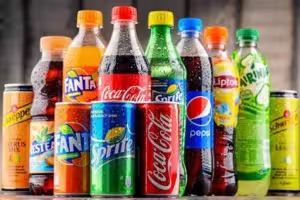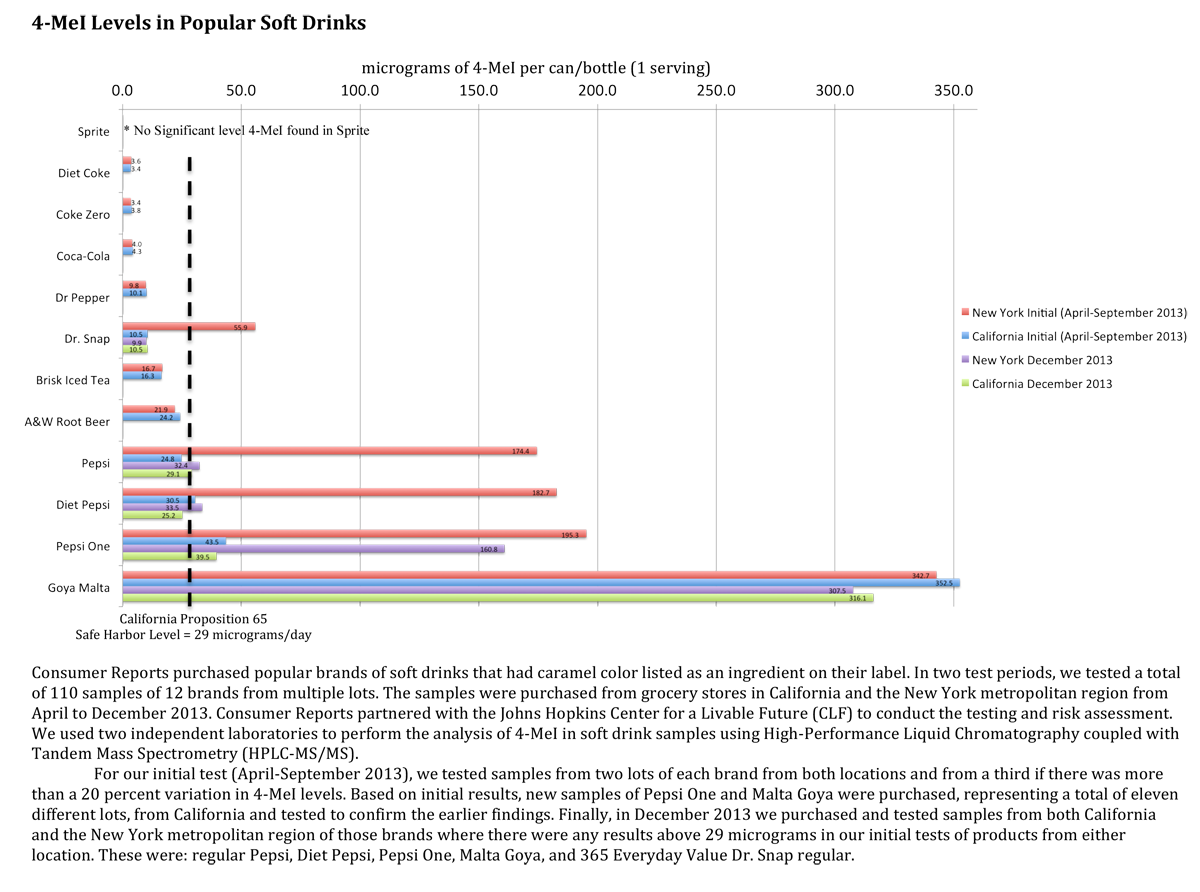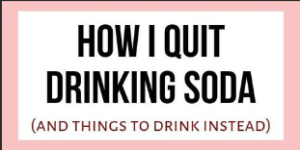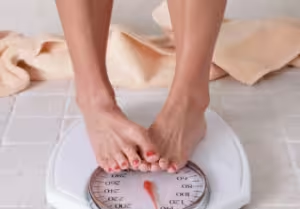Beyond the Scale: Nurturing Emotional Well-Being on Your Weight Loss Journey
by Trish Siems | May 12, 2025 | In Store Deals, Latest Weight Loss News, Success Stories, Uncategorized, Weight Loss Injections, Weight Loss Tips | 0 Comments
Beyond the Scale: Nurturing Emotional Well-Being on Your Weight Loss Journey
Embarking on a weight loss journey often feels like a battle against the numbers on the scale, but what if we shifted the focus to nurturing our emotional well-being? By embracing self-love and resilience, we can transform weight loss into a powerful journey of self-discovery and fulfillment. In this digital age, where external validation often overshadows internal peace, prioritizing your emotional health can create a lasting impact on your overall transformation.
The Emotional Terrain of Weight Loss

Weight loss is frequently perceived as a purely physical transformation; however, the emotional aspects play an equally crucial role. The emotional ups and downs, ranging from self-doubt to motivation, form the backbone of this journey. It’s essential to recognize and address these emotional factors to ensure sustainable progress.
According to the American Psychological Association, acknowledging emotions can help in dealing with stress more effectively. This process involves:
- Identifying emotional triggers that may lead to unhealthy eating habits.
- Developing coping mechanisms to handle setbacks.
- Celebrating small victories to boost morale and self-esteem.
Resilience and Self-Compassion as Allies
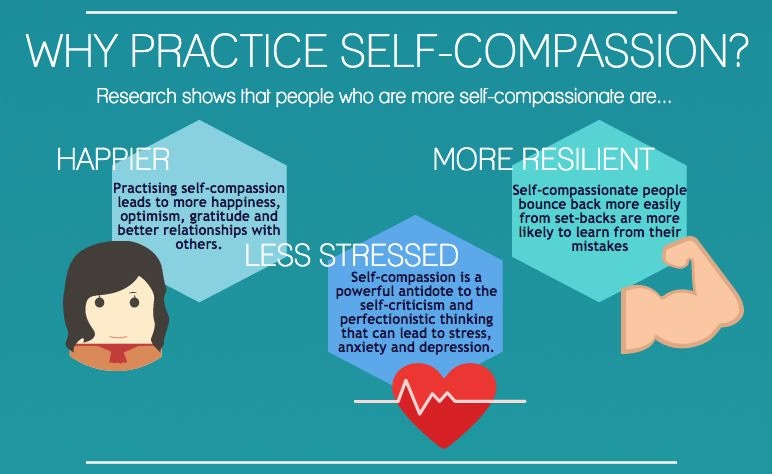
Building resilience and practicing self-compassion are fundamental in overcoming the challenges of a weight loss journey. Resilience allows you to bounce back from setbacks, while self-compassion helps you treat yourself with kindness in moments of struggle. These qualities are not innate; they can be cultivated with conscious effort and mindfulness practices.
Strategies to Cultivate Resilience
- Mindfulness Meditation: Engage in daily mindfulness practices to enhance self-awareness and emotional regulation.
- Goal Setting: Establish realistic and achievable goals to maintain motivation and direction.
- Community Support: Join groups or forums that offer shared motivation and accountability.
The Role of Self-Love in Weight Loss

Developing a strong sense of self-love can significantly aid your weight loss journey. Self-love involves accepting yourself wholly, recognizing your worth beyond physical appearance, and nurturing your mental and emotional health. According to Healthline, self-love is critical in developing healthy habits and achieving sustainable weight management.
Practicing self-love can involve:
- Engaging in positive self-talk and affirmations.
- Setting boundaries and prioritizing your needs.
- Indulging in activities that bring joy and relaxation.
Creating a Supportive Environment

Surrounding yourself with a supportive community can provide the encouragement and motivation needed to persevere through challenging times. Engaging with others who share similar goals can enhance your experience, offer accountability, and provide a sense of belonging.
Consider participating in mindfulness challenges and connecting with like-minded individuals who value emotional well-being as a cornerstone of their weight loss process.
As you navigate your weight loss journey, remember that it’s not merely about reaching a destination; it’s about enriching your life with self-love, resilience, and emotional well-being. By nurturing these aspects, you unlock the potential for profound and lasting change, transforming your weight loss journey into a fulfilling and empowering experience.
10 Powerful Tips to Stay Motivated on Your Weight Loss Journey
by Trish Siems | January 23, 2025 | In Store Deals, Latest Weight Loss News, Weight Loss Tips | 0 Comments
Losing weight can be a challenging journey, filled with ups and downs. Motivation is key to pushing through these obstacles and achieving your health goals. At Slim180 Weight Loss Centers, we understand the importance of maintaining motivation throughout your weight loss journey to promote heart health and reduce the risk of cardiovascular disease.
1. Set Clear Goals
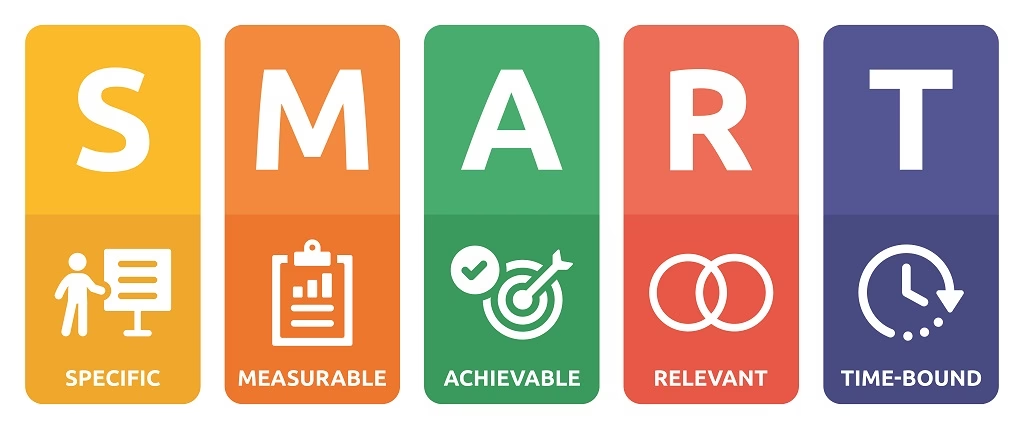
Starting with well-defined goals sets the foundation for success. Consider setting SMART goals—Specific, Measurable, Achievable, Relevant, and Time-bound. For example, aim to lose 5 pounds in two months rather than simply saying, “I want to lose weight.”
2. Track Your Progress

Monitoring your progress regularly can be a powerful motivator. Use a journal or a mobile app to record your weight, measurements, and diet. Noticing even small improvements can boost your morale and keep you on track.
3. Create a Support Network

Surrounding yourself with supportive friends and family can make a world of difference. Join an online community or local support group where you can share experiences, gain insights, and celebrate successes together.
Benefits of a Support Network:
- Emotional encouragement
- Accountability partners
- Sharing tips and experiences
4. Celebrate Milestones

Recognize the importance of celebrating your achievements, no matter how small. Reward yourself with non-food treats like a new book, a relaxing bath, or a special outing. Celebrating milestones keeps your journey enjoyable and fulfilling.
5. Focus on Heart Health

Remember, weight loss isn’t just about appearance; it’s about improving your heart health. According to the Centers for Disease Control and Prevention (CDC), maintaining a healthy weight lowers the risk of heart disease, which is especially important for women.
6. Mix Up Your Exercise Routine
Variety keeps exercise exciting and prevents burnout. Try different activities like yoga, swimming, or cycling. Incorporating a mix of cardiovascular, strength, and flexibility exercises not only aids weight loss but also enhances overall fitness.
7. Practice Mindfulness and Stress Management

Stress can be a major barrier to weight loss. Engage in mindfulness practices such as meditation or deep-breathing exercises. According to research, mindfulness helps to reduce stress and improve emotional eating habits.
8. Educate Yourself on Nutrition
Understanding nutrition helps you make informed choices. The AHA offers resources on healthy eating, which can guide you in selecting heart-healthy foods that support weight loss.
9. Visualize Your Success

Visualization is a powerful tool. Picture yourself reaching your goals and feeling healthier and more energetic. This mental rehearsal boosts motivation and helps reinforce positive behavior.
10. Be Kind to Yourself
Remember, it’s okay to have setbacks. Treat yourself with compassion and avoid negative self-talk. Acknowledge your efforts and keep pushing forward. The journey to a healthier heart is a marathon, not a sprint.

Embarking on a weight loss journey is as much about mental resilience as physical changes. Stay motivated by setting realistic goals, seeking support, and focusing on the long-term benefits for your heart. Slim180 Weight Loss supports your journey towards a healthier, happier you.
Unraveling the Connection: How Stress Influences Thyroid Health
by Trish Siems | January 18, 2025 | In Store Deals, Latest Weight Loss News, Success Stories, Weight Loss Tips | 0 Comments
In our fast-paced world, stress has become an ever-present companion, often lurking in the shadows of our daily lives. While it is widely recognized that stress affects mental health, fewer people are aware of its profound impact on physical well-being, particularly its influence on the thyroid gland. The thyroid, a small, butterfly-shaped organ located at the base of the neck, plays a vital role in regulating metabolism, energy, and overall hormonal balance. Understanding how stress impacts this essential gland can arm you with the tools to maintain optimal thyroid health.
The Physiology of Stress and Thyroid Interaction
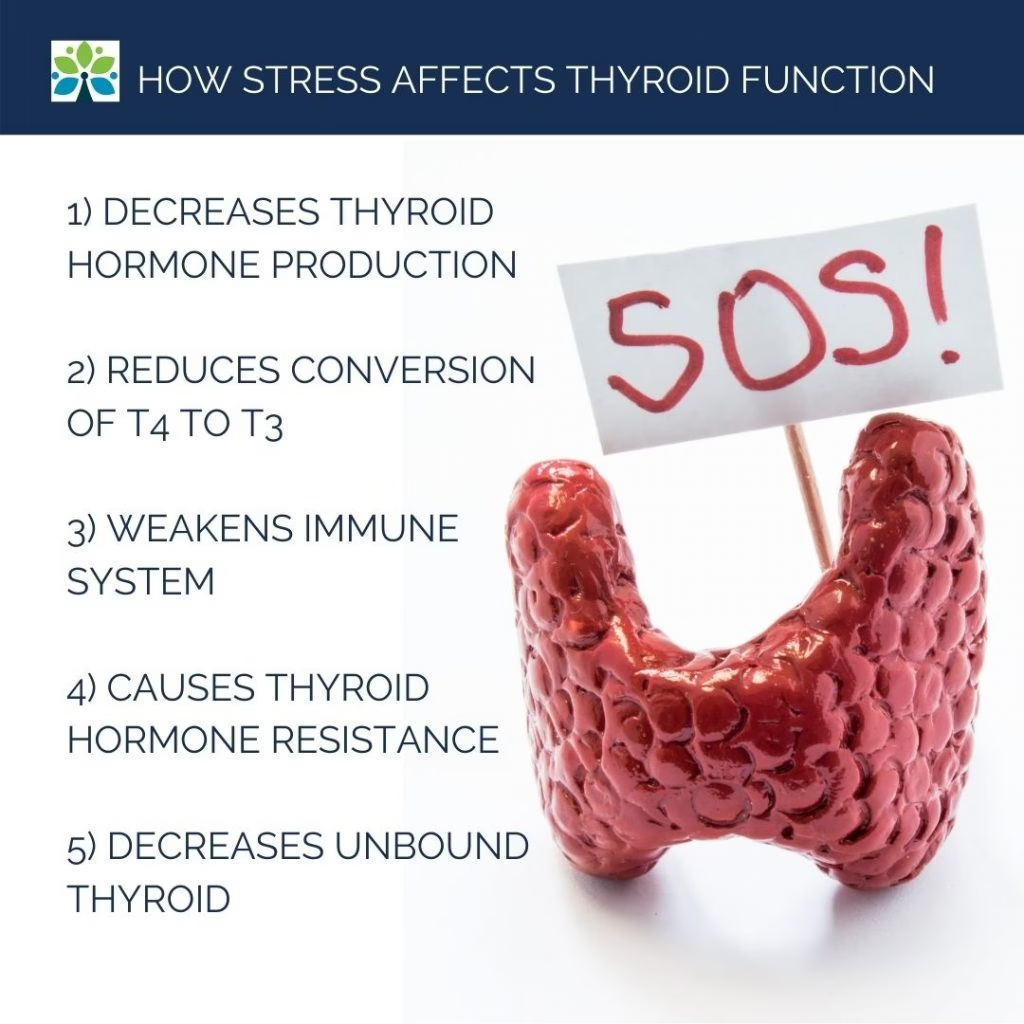
When you encounter stress, your body responds by releasing stress hormones such as cortisol from the adrenal glands. This response is part of the hypothalamic-pituitary-adrenal (HPA) axis. However, chronic stress can disrupt this delicate balance, affecting the function of the thyroid gland. Elevated cortisol levels can suppress the conversion of thyroxine (T4) to triiodothyronine (T3), the active form of thyroid hormone, which can lead to symptoms of hypothyroidism.
Symptoms of Stress-Induced Thyroid Dysfunction
When stress negatively impacts thyroid function, it can manifest through a variety of symptoms, often masquerading as everyday ailments. These symptoms include:
- Fatigue: Despite adequate sleep, you may feel persistently tired and lethargic.
- Mood Swings: Stress hormones can exacerbate anxiety and depression, compounding emotional instability.
- Weight Changes: Unexplained weight gain or loss may occur due to disruptions in metabolic rate.
Managing Stress for Thyroid Health

Given the intricate connection between stress and thyroid function, adopting strategies to manage stress effectively is crucial. Here are some evidence-based approaches to reduce stress and support thyroid health:
- Mindfulness and Meditation: Practicing mindfulness or meditation can help calm the mind and reduce cortisol levels. The National Institute of Health supports these practices for stress reduction.
- Physical Activity: Regular exercise is a natural stress reliever. It also promotes better sleep and helps maintain a healthy weight.
- Balanced Diet: Consuming a diet rich in whole foods, including healthy fats and appropriate iodine levels, supports thyroid function. Ensure your diet includes adequate amounts of selenium, zinc, and iron, which are crucial for thyroid health.
- Sleep Hygiene: Prioritizing quality sleep each night aids in stress management and hormonal balance.
Consultation and Personalized Care

If you suspect that stress is affecting your thyroid health, consulting with healthcare professionals is essential.
- Diagnostic Evaluations: Blood tests and imaging to assess thyroid function and structure.
- Tailored Treatment Plans: Management strategies to address individual needs, including medication and lifestyle modifications.
- Expert Consultations: Access to endocrinologists who specialize in thyroid health.
In conclusion, while stress is an unavoidable aspect of life, its impact on thyroid function can be profound. By understanding the complex relationship between stress and the thyroid, you can take proactive steps to support your health. Remember, managing stress is not just about improving mental well-being; it’s about fostering a holistic balance that enhances every aspect of your life.
New years resolution: Making Weight Loss Sustainable
by Trish Siems | December 26, 2024 | In Store Deals, Latest Weight Loss News, Success Stories, Weight Loss Tips | 0 Comments
New years resolution: Making Weight Loss Sustainable
New Year’s resolutions are a popular tradition in many parts of the world. Each year, people make promises to themselves to improve their lives. Among the countless resolutions, one of the most common is losing weight. How can sustainable weight loss
Despite its popularity, losing weight and getting fit can be one of the most challenging resolutions to keep. Many people start the new year filled with motivation and determination, only to give up on their weight loss journey within a few months.
If you’ve struggled to make weight loss a lasting commitment, Slim180 Weight Loss is here to support you. Our experts have compiled some tips to help you make your weight loss resolution sustainable.
Why Do Weight Loss Resolutions Fail So Often?

There are several reasons why weight loss resolutions fail so often:
- Unrealistic Expectations: Many people set unattainable goals, such as losing weight rapidly. When they do not see immediate results, they often feel discouraged and give up.
- Lack of Planning: Individuals frequently make vague resolutions to “eat healthier” or “exercise more” without creating a specific plan. Without a clear course of action, it can be easy to revert to old habits.
- Restrictive Diets: Crash diets or extreme restrictions on food intake are typically not sustainable in the long term. They can lead to binge eating and weight gain once the diet is over.
- Lack of Support: Attempting to lose weight alone can be challenging. Without a support system, it is easy to become discouraged and abandon efforts.
- Perfectionism: Many individuals adopt an all-or-nothing mindset when it comes to weight loss. If they make a mistake or slip up, they may feel like they have failed and give up entirely.
- Emotional Eating: Food is often used as a coping mechanism for stress, sadness, and boredom. When trying to lose weight, it’s crucial to address the underlying emotional reasons for overeating.
Why is Sustainable Weight Loss Important?

Sustainable weight loss means making long-term changes to your lifestyle that you can maintain for the rest of your life. It involves creating healthy habits and balancing nutritious eating and regular physical activity.
So why is it important?
- – Maintaining a healthy weight reduces the risk of obesity-related health issues.
- – Engaging in regular physical activity improves overall health and well-being, including mental health, energy levels, and self-confidence.
- – Leading a healthy lifestyle sets a positive example for others and can inspire them to make positive changes in their own lives.
How Can I Make Weight Loss Sustainable?
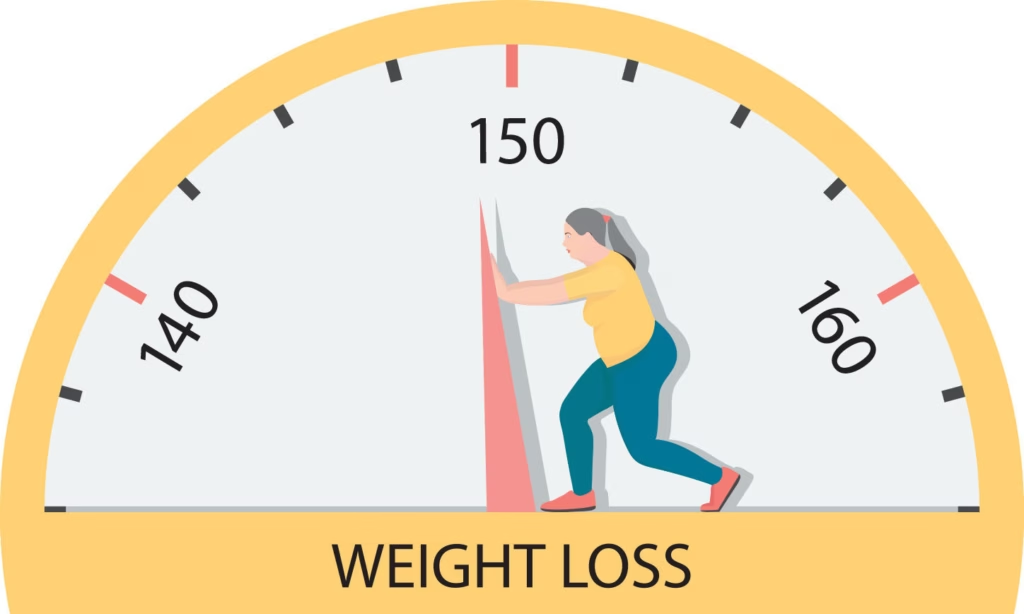
Here are some tips to help you stick to your New Year’s resolution and achieve your weight loss goals:
Start With a Realistic Goal
One of the most common reasons weight loss resolutions fails is people set unrealistic or undefined goals. To avoid this, use the SMART method.
What is the SMART Method of setting goals?

The SMART method is an acronym for Specific, Measurable, Achievable, Realistic, and Time-bound. It is a goal-setting technique that helps individuals create clear and realistic goals.
- Specific: A specific goal clearly defines what you want to achieve. Instead of saying, “I want to lose weight,” specify how much weight you want to lose and within what timeframe.
- Measurable: A measurable goal allows you to track your progress and stay motivated. Rather than saying, “I want to be healthier,” set a specific target, such as, “I want to exercise for 30 minutes three times a week.”
- Achievable: An achievable goal is one that you can realistically reach. It’s important to set goals that challenge you but remain within your capabilities. For example, aiming to lose 20 pounds in one month is neither achievable nor healthy, but a goal to lose 1-2 pounds per week is reasonable.
- Realistic: A realistic goal takes your abilities and limitations into account. It should also align with your lifestyle and values. For instance, setting a goal to run a marathon may be unrealistic if you don’t enjoy running.
- Time-bound: A time-bound goal has a specific deadline or timeframe. This creates a sense of urgency and accountability in your pursuit of the goal.
Instead of saying, ‘I want to lose weight,’ say, ‘I want to lose 10 pounds in three months.’
Using this method to set your weight loss goals, you create a clear roadmap for yourself and increase your chances of success.
Create a Plan
Once you have set a realistic goal, the next step is to create a plan to achieve it. This plan should include specific actions you will take, such as meal planning and exercise routines
Here are some examples of actions you can include in your plan:
- Plan your meals for the week in advance to ensure you have healthy options readily available and to minimize the temptation of unhealthy choices.
- Stop adhering to strict rules and restrictions; instead, prioritize incorporating healthy foods into your diet in moderation. Remember that fad diets may promise quick weight loss, but they are ultimately unsustainable and can be detrimental to your health.
- Adopt the 80-20 rule: 80% of your diet should be composed of nutrient-dense, whole foods, while the remaining 20% should be reserved for occasional treats without guilt.
- Make exercise non-negotiable by scheduling specific times for physical activity, whether it’s hitting the gym, going for a walk, or participating in a fitness class.
A well-defined plan makes staying on track and monitoring your progress easier. It also helps you identify potential obstacles and develop solutions in advance.
Find a Support System
A support system is crucial for achieving weight loss goals. Friends, family, or online communities can provide the necessary motivation and accountability.
For personalized support, consider joining Slim180 Weight Loss. Our team of professionals offers customized plans and ongoing support to help you achieve sustainable weight loss and enhance your overall health.
Focus on Progress, Not Perfection
Perfectionism can often lead to individuals abandoning their weight loss goals. However, it’s important to recognize that mistakes and setbacks are a natural part of any journey. Instead of feeling discouraged by a slip-up, shift your focus to your overall progress and take proactive steps to continue moving forward.
For instance, if you have a day where your eating habits don’t align with your goals, acknowledge it without judgment and then let it go. One setback doesn’t define your progress; instead, use it as an opportunity to motivate yourself towards healthier choices in the future.
Remember, weight loss is about more than just the number you see on the scale. Pay attention to how you feel both physically and mentally as you embrace lifestyle changes. Celebrate those non-scale victories as well, such as finding that your clothes fit better or noticing an increase in your energy levels. Each positive change is a step towards your overall well-being..
Address Emotional Eating
Emotional eating is a common obstacle to achieving sustainable weight loss. Many individuals turn to food for comfort or distraction when faced with challenging emotions such as stress, sadness, or boredom. This behavior can lead to overeating and hinder progress toward weight loss goals.
For instance, if you find yourself reaching for food when you’re stressed, consider taking a walk or talking to a friend instead. These alternative coping mechanisms can help break the cycle of emotional eating.
Stay Patient and Persistent
Get ready to embrace an adventure! Sustainable weight loss is all about the journey, and it’s one that requires your commitment and enthusiasm. Forget about quick fixes or one-time efforts; this is your chance to shine through dedication and resilience!
Even when the results aren’t instant or challenges pop up, keep your eyes on the prize. Your goals are within reach! Stay focused, be patient, and take bold steps toward transforming into the healthiest and happiest version of yourself. Remember, this isn’t just about shedding pounds—it’s about creating an exhilarating, sustainable lifestyle that you’ll love in the long run! Let’s do this!
What Are the Signs of Healthy, Sustainable Weight Loss?

Here are some ways to measure progress outside of the scale.
- Body Measurements: Instead of concentrating solely on weight, monitor your body measurements, such as waist circumference, hip size, and body fat percentage.
- Energy Levels: As you adopt healthier lifestyle changes, you may notice an increase in your energy levels and a decrease in fatigue. Pay attention to how you feel throughout the day.
- Sleep Quality: Improving your overall health can also enhance the quality of your sleep, which is vital for weight loss and overall well-being.
- Clothing Size: Take note if your clothes are fitting more loosely or if you can wear smaller sizes as a result of your weight loss.
- Fitness Improvements: Track your progress in the gym or during physical activities. You might find that you can perform more repetitions, lift heavier weights, or run longer distances due to your weight loss efforts.
Each person’s weight loss journey is unique, with its ups and downs. The most important aspect is to remain committed, be patient, and celebrate every progress made along the way.
Start Your Sustainable Weight Loss Journey Today with Slim180 Weight Loss

Weight loss can be challenging, but it can be both successful and sustainable with the right strategies and support. By setting realistic goals, creating a solid plan, seeking support, practicing self-compassion, and addressing emotional eating, you can overcome obstacles and make progress toward a healthier lifestyle. If you need additional guidance on your weight loss journey, consider reaching out to a reputable clinic or specialist.
Slim180 Weight Loss is a leading weight loss clinic in St Louis that offers comprehensive weight loss services, including a physician-supervised weight loss program designed to help individuals lose weight safely and effectively.
Don’t let your New Year’s resolution to lose weight slip away. Start your sustainable weight loss journey today with our Slim180 Weight Loss program. Schedule an appointment now to take the first step toward a healthier, happier you.
FAQs

How can Slim180 Weight Loss help me in my weight loss journey?
Slim180 Weight Loss provides personalized support and guidance from medical professionals, along with customized plans tailored to your individual needs and goals. They offer ongoing assistance to help you achieve sustainable weight loss. Slim180 equips you with the necessary tools and resources for a successful weight loss journey. If you’re finding it difficult to lose weight on your own, consider reaching out to Slim180 Weight Loss for help.
What are the basic rules for losing fat?
- To successfully lose fat, follow these basic rules:
- Create a calorie deficit by consuming fewer calories than you burn through daily activities and exercise.
- Focus on including nutrient-dense, whole foods in your diet, such as fruits, vegetables, lean proteins, and healthy fats.
- Limit your intake of processed and sugary foods that are high in calories but low in nutritional value.
- Engage in regular physical activity, incorporating both cardio and strength training exercises.
- Be patient and consistent with your efforts, as sustainable weight loss takes time.
- If needed, seek support from healthcare professionals or a reputable weight loss program.
Why is the patience necessary when trying to lose weight?
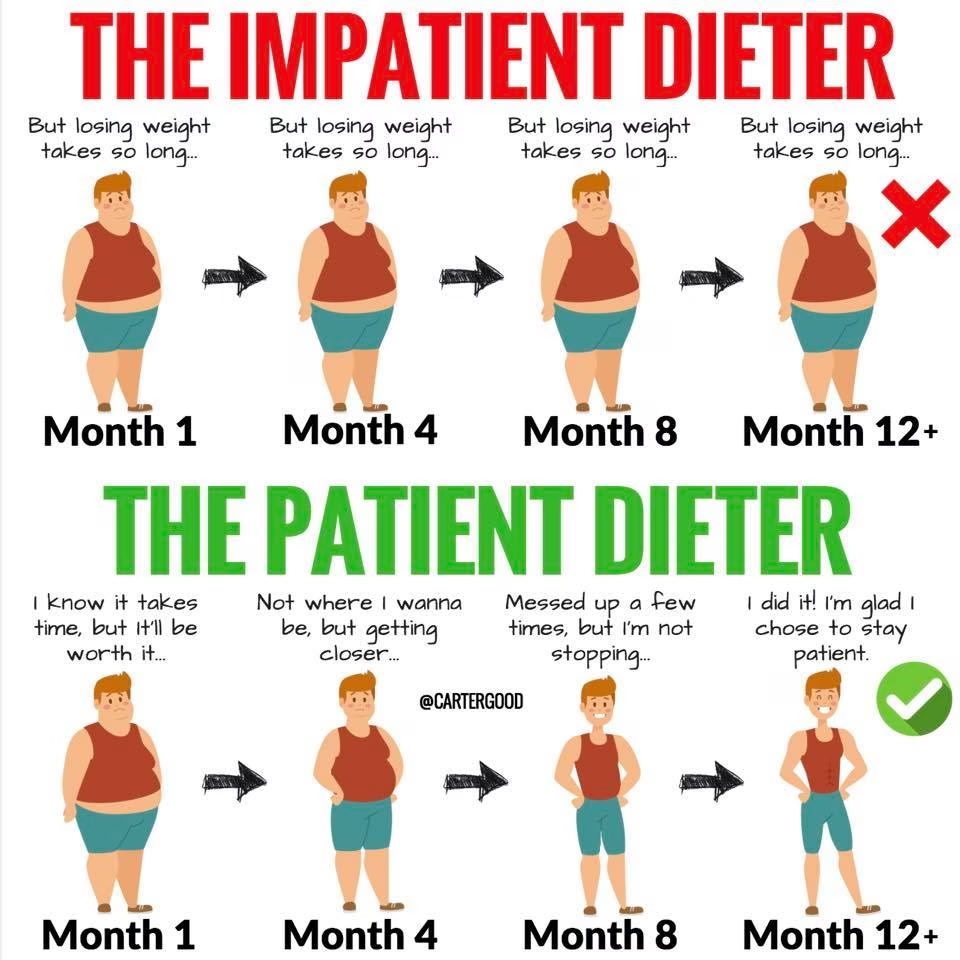
Sustainable weight loss requires time and patience. It’s a long-term lifestyle change, not a quick fix. Stay persistent and patient as you work toward your goals. Slow and steady progress is better than none, and patience is essential for lasting results.
Can I still enjoy my favorite foods while I work on losing weight gradually?
It’s essential to maintain balance and moderation in your eating habits. You can enjoy your favorite foods in moderation as part of a healthy diet. Focus on finding what works for you, incorporating healthier versions or smaller portions of those foods. It’s about creating a sustainable lifestyle, not restricting yourself. For personalized advice, consult your physician or nutritionist.
Is it safe to lose weight quickly?
Losing weight too quickly can be dangerous and harmful to your health. Aim for a gradual and sustainable weight loss rate of 2 to 5 pounds weekly. This approach helps ensure you lose fat rather than muscle and allows your body time to adjust to the changes.
Can sustainable weight loss lower blood pressure?
Sustainably losing weight can lower high blood pressure. Being overweight is linked to hypertension, so shedding pounds reduces the strain on your heart and improves cardiovascular health.
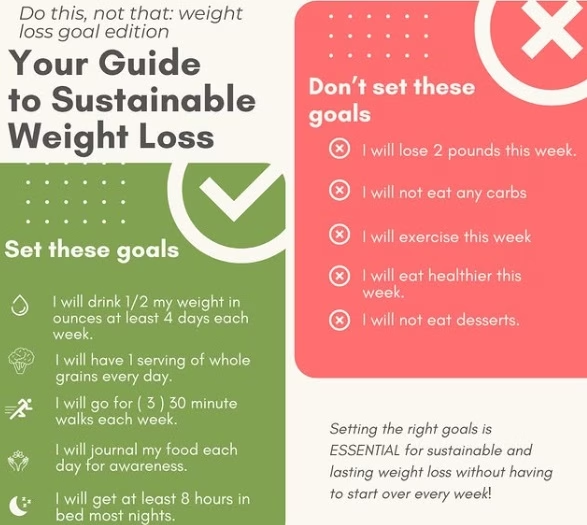
Breaking Down Lipolean Injections: Top Ingredients and Their Benefits
by Trish Siems | October 21, 2024 | In Store Deals, Latest Weight Loss News, Weight Loss Tips | 0 Comments
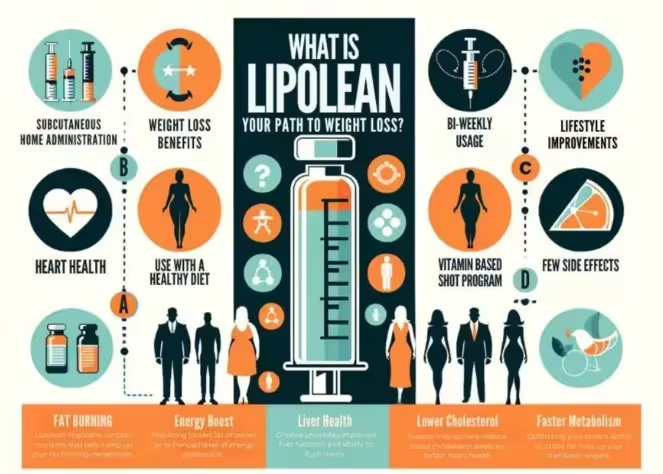
Excited to learn about Lipolean injections and their weight loss benefits? Let’s get into it! Lipolean injections are packed with powerful ingredients that turbocharge your body’s fat metabolism and help you crush your weight loss goals. But what exactly are these supercharged components, and how do they work their magic? Get ready to uncover the secrets of Lipolean injections and how they could supercharge your weight loss journey!
What we will discuss:
- Lipolean injections contain essential ingredients such as B vitamins (B12 and B6) and amino acids (methionine, inositol, and choline) that support fat metabolism and aid in weight loss.
- Methionine is essential for breaking down fats, promoting fat cell elimination, and supporting liver function and detoxification.
- Inositol supports fat metabolism, improves insulin function, aids brain health, and contributes to weight loss when combined with a healthy diet and exercise.
- Choline plays a crucial role in supporting fat and cholesterol metabolism, promoting liver function, and enhancing the breakdown of fats when combined with other ingredients in lipolean injections.
Understanding Lipolean Injections
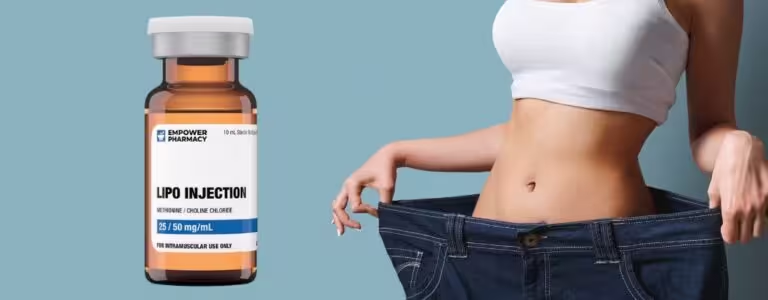
If you’re curious about Lipolean injections, they work by supporting fat metabolism through essential ingredients like B vitamins and amino acids.
These injections are a valuable addition to your weight loss journey, containing essential vitamins for fat burning. B vitamins like B12 and B6 boost metabolism, while amino acids like methionine, inositol, and choline support fat metabolism alongside exercise and diet.
It’s crucial to understand that Lipolean injections must be used alongside a healthy diet and exercise program for the best results. By integrating these injections into your routine, you will effectively boost your metabolism and bolster your fat-burning endeavors.
Key Ingredients of Lipolean Injections

The key ingredients in Lipolean injections, including B vitamins and essential amino acids, play a crucial role in supporting fat metabolism and enhancing your weight loss efforts. These nutrients are essential for boosting metabolic processes, improving energy levels, and helping you achieve your weight loss goals.
Here’s how they work:
- B Vitamins: B vitamins, particularly B12 and B6, aid in converting food into energy, supporting exercise, and maintaining a healthy diet.
- Essential Amino Acids: Amino acids like methionine, inositol, and choline assist in fat metabolism, providing a boost to your weight loss journey and promoting overall well-being.
- Metabolic Processes: The key ingredients help in optimizing metabolic processes, ensuring that your body efficiently utilizes nutrients, burns fat, and supports your weight loss goals.
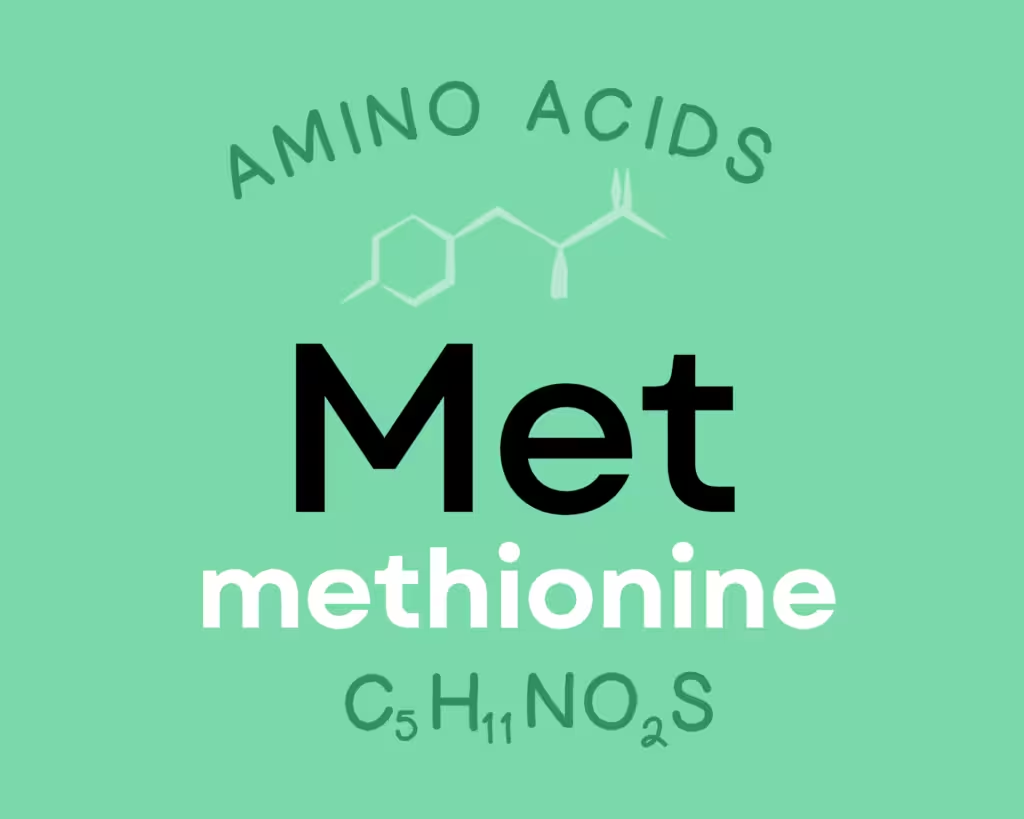
Methionine: Role and Benefits
Methionine plays a crucial role in supporting metabolism and fat removal. It is a key amino acid with significant benefits for weight loss and overall well-being. As an essential nutrient, methionine helps to break down fats in the body, acting as a lipotropic agent that aids in the elimination of fat cells. By supporting liver function and detoxification processes, methionine contributes to a healthy metabolism and efficient fat excretion.
When combined with a balanced diet and exercise, methionine can help improve energy levels and promote weight loss. Including methionine in lipolean injections enhances their effectiveness in supporting fat metabolism and overall body wellness. Therefore, ensuring an adequate intake of methionine is essential for those seeking to achieve and maintain a healthy weight while supporting their body’s natural fat-removal processes.
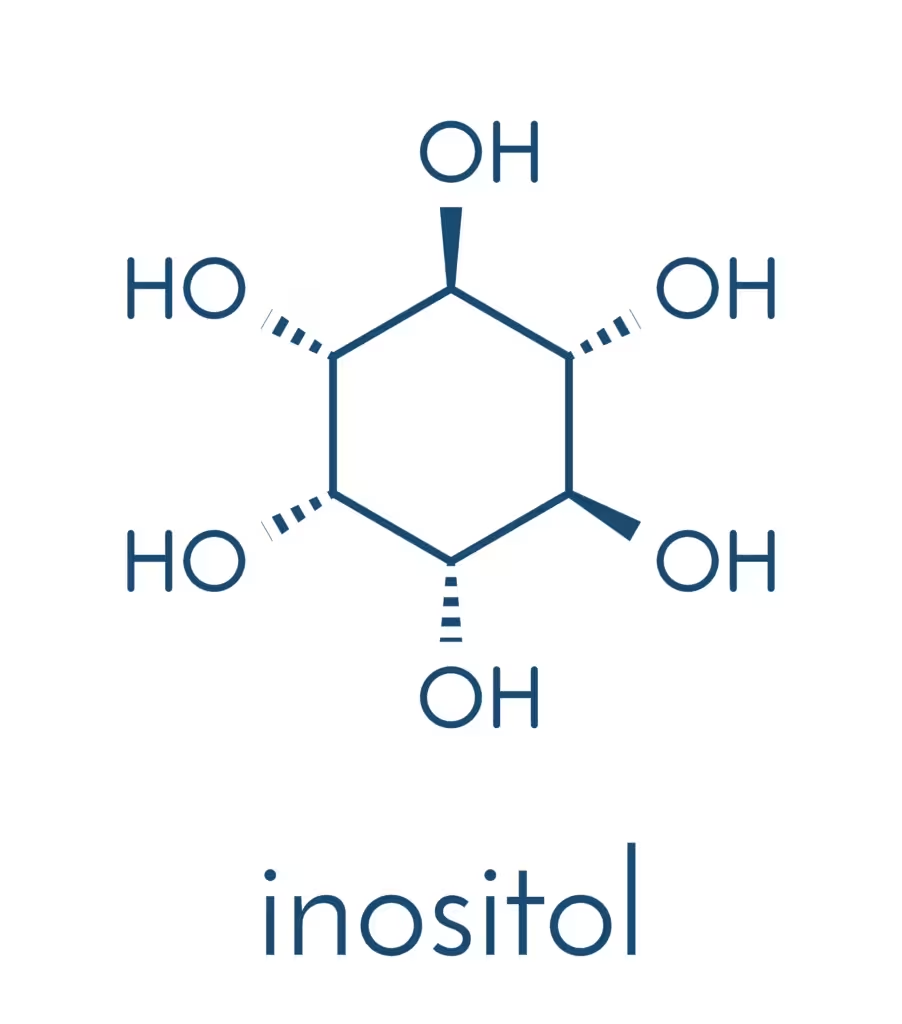
Inositol: Role and Benefits
Inositol is a key contributor to fat metabolism and is essential to Lipolean injections, where it facilitates fat burning. Moreover, it can potentially enhance insulin function, thereby aiding in regulating blood sugar levels. Furthermore, inositol is essential for maintaining optimal brain health and regulating mood, thus offering comprehensive benefits for overall well-being.
Inositol: Function and Benefits
Inositol is essential for maintaining healthy cell membranes and is crucial in fat burning. It may also improve insulin function. When it comes to achieving weight loss, inositol is vital because it helps break down fats in the body. Supporting your efforts when combined with a healthy diet and exercise.
In addition, inositol supports overall liver health and may help control cholesterol levels. To maximize the benefits of inositol, it’s essential to pair its effects with a balanced intake of vitamins and minerals and a commitment to regular physical activity.
While inositol can offer a potential energy boost and help your body burn fat more effectively, it’s essential to be aware of possible side effects and consult a healthcare professional to ensure it aligns with your specific goals and needs.
Inositol: Health Benefits
When aiming to improve fat metabolism and support weight management, inositol plays a crucial role by promoting healthy fat absorption and weight loss. This nutrient enhances the body’s metabolic processes, making it easier for fat cells to absorb and break down fats. Incorporating these injections into your diet and exercise regimen can boost energy levels, enhance insulin function, and achieve more effective weight loss. Inositol is an essential nutrient that supports fat metabolism, making it valuable in reaching your weight loss and overall health goals. Its benefits also extend to hormone regulation and improving insulin sensitivity, further enhancing its impact on your wellness journey.

Choline: Role and Benefits
Choline plays a crucial role in the metabolism of fats and cholesterol. It supports liver function and aids in the transport of fats. Choline is one of the essential nutrients that can help the body break down fats more efficiently.
When combined with other ingredients in lipolean injections, choline can support a healthy metabolism and help burn fat more effectively. These injections contain a blend of essential nutrients that can aid in weight loss and overall wellness when combined with a proper diet.
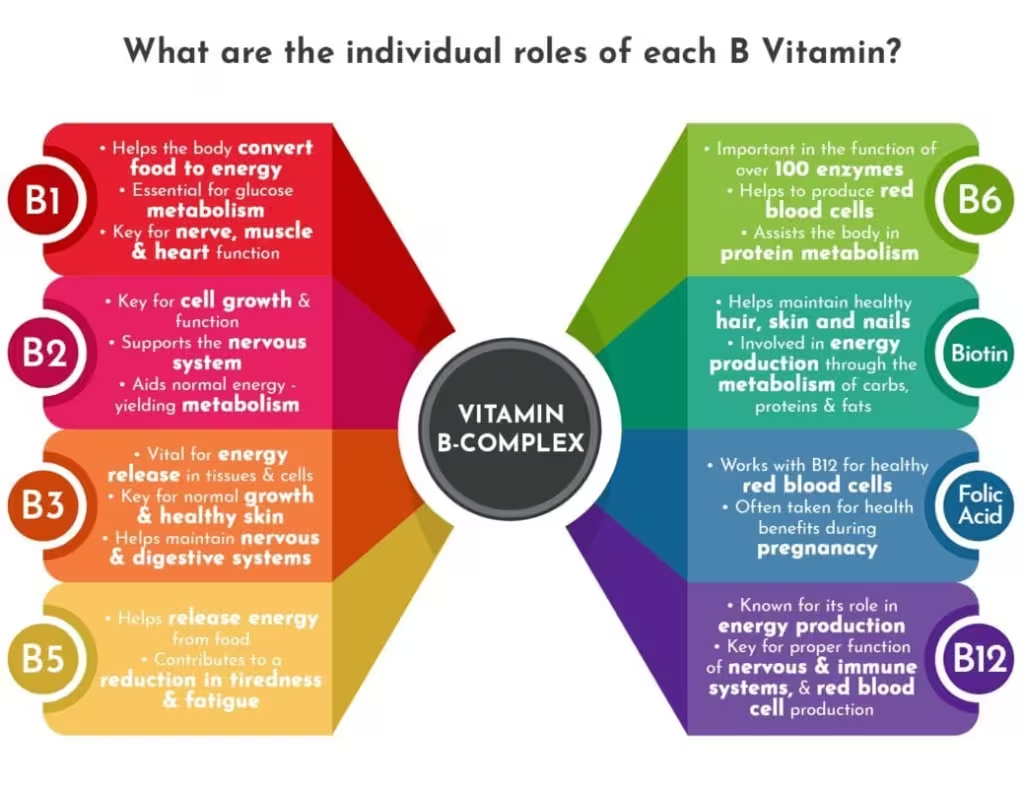
B Vitamins: Role and Benefits
B vitamins, including B12, are essential nutrients that support the body’s metabolism and energy production. They play crucial roles in promoting healthy metabolism and aiding in weight management by improving the breakdown of fats, proteins, and carbohydrates for energy. Adequate intake of B vitamins is important for maintaining a healthy nervous system, promoting overall well-being, and preventing fat accumulation.
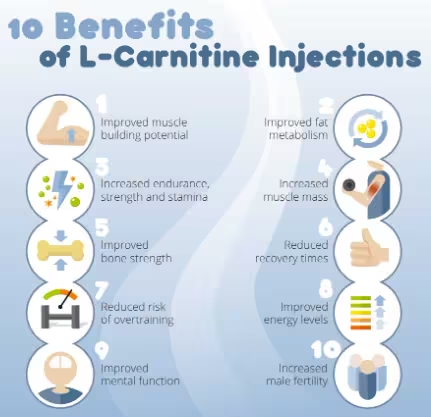
L-Carnitine: Role and Benefits
L-carnitine is a key player in your body’s ability to convert fat into energy. It’s responsible for shuttling fatty acids to the mitochondria, where they’re used to produce energy.
L-Carnitine: Metabolism Benefits
L-carnitine supports metabolism by transporting fatty acids into cells for energy use. It plays a crucial role in the breakdown of fats and may also enhance exercise performance and endurance. It helps to metabolize stubborn fat, allowing you to achieve the best results in your weight loss journey.
L-Carnitine benefits your metabolism:
- Fat Metabolism: L-Carnitine aids in the breakdown of fats for energy production in the body.
- Improved Exercise Performance: It may enhance exercise performance and endurance by reducing lactic acid build-up in muscles.
- Liver Function: L-Carnitine supports liver function and the transportation of toxic compounds out of cells, aiding in detoxification.
L-Carnitine: Energy Production
This ingredient plays a key role in energy production. It helps transport fatty acids into mitochondria for use as an energy source. When L-carnitine is included in Lipolean injections, it can aid the body’s natural ability to burn fat and produce energy.
This blend of vitamins and L-carnitine is safe and effective for many individuals. It’s important to discuss the potential effects of lipo injections with a healthcare professional.
L-carnitine not only assists in weight loss by promoting fat as an energy source. Also supports improved exercise performance and endurance. Additionally, it has been linked to enhanced heart and brain function.
It’s best to consult a healthcare provider to ensure they suit your needs and health status.
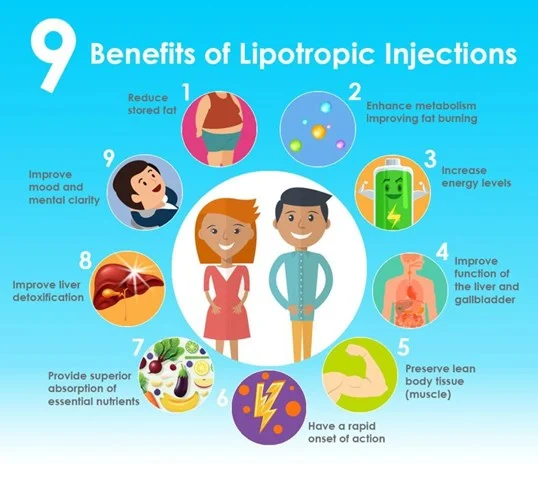
Benefits of Lipolean Injections
Improving metabolism and supporting fat burning, Lipolean injections offer a range of benefits for those seeking to enhance their weight loss efforts and overall well-being. The top ingredients in Lipolean injections, such as B vitamins and amino acids, contribute to these benefits.
Here are some benefits of Lipolean injections:
- Increased energy levels and reduced hunger and cravings make sticking to a healthy diet easier.
- Improved liver function supports the body’s ability to metabolize fat and detoxify.
- Contribution to weight loss efforts, helping you see results more effectively.
Lipolean injections are suitable for everyone looking to support their weight loss journey. If you have any concerns, discussing them with your Weight Loss Counselor can help ensure the injections are right for you.
Conclusion
So, now that you know the top ingredients in Lipolean injections and their benefits, it’s time to put this theory to the test. Try incorporating Lipolean injections into your weight loss journey and see if they truly live up to their claims. With the right diet and exercise, you may find that Lipolean injections can give you the extra boost you need to reach your weight loss goals.
Stay Hydrated: Essential Water Intake and Effective Tips to Keep You Hydrated!
by Trish Siems | September 3, 2024 | In Store Deals, Latest Weight Loss News, Uncategorized, Weight Loss Tips | 0 Comments
Stay Hydrated: Essential Water Intake and Effective Tips to Keep You Hydrated!
Water is essential for the proper functioning of every cell in the body. It aids the digestive system, helps prevent constipation, flushes toxins from the body, promotes good kidney function, keeps joints and muscles lubricated, supports healthier and younger-looking skin, and helps regulate body temperature. To reap all these benefits effectively, it’s essential to stay hydrated.
Slim180 Weight Loss recommends this minimum daily intake of water:
- 10 cups, 80 ounces daily
You lose water through breathing, sweating, urination, and bowel movements. It is important to continually replenish your body’s water supply by consuming water-containing foods and beverages. Approximately 20% of your daily liquid intake comes from food, with the remaining 80% coming from drinks for staying hydrated.
Certain individuals, including infants, young children, and people who work or exercise outdoors, are more likely to become dehydrated. Even mild dehydration can cause tiredness and low energy levels. Moreover, older adults are at a higher risk of dehydration due to a reduced fluid reserve, decreased ability to conserve water, and a less acute sense of thirst as they age. Chronic illnesses such as diabetes and dementia, as well as certain medications, can exacerbate these issues. Additionally, mobility issues in older adults can limit their ability to access water.
How can you tell if you’re drinking enough water?
You are consuming enough fluids if you rarely feel thirsty and your urine is colorless or light yellow. To ensure you stay hydrated, drink water regularly with meals, during exercise, and whenever you feel thirsty. Although increasing your water intake may appear effortless, it does require significant effort to remember to do so.
Here are some tips for upping your water game:
Flavor it.
Add fruit to your water: lemons, limes, and oranges are classic choices, while cucumbers, watermelon, strawberries, and herbs are also delightful options to make drinking water more enjoyable and help you stay hydrated.

Tie it into a routine.
Drink a glass of water every time you brush your teeth, eat a meal, or use the bathroom. This practice ensures that you stay consistently hydrated throughout your day.
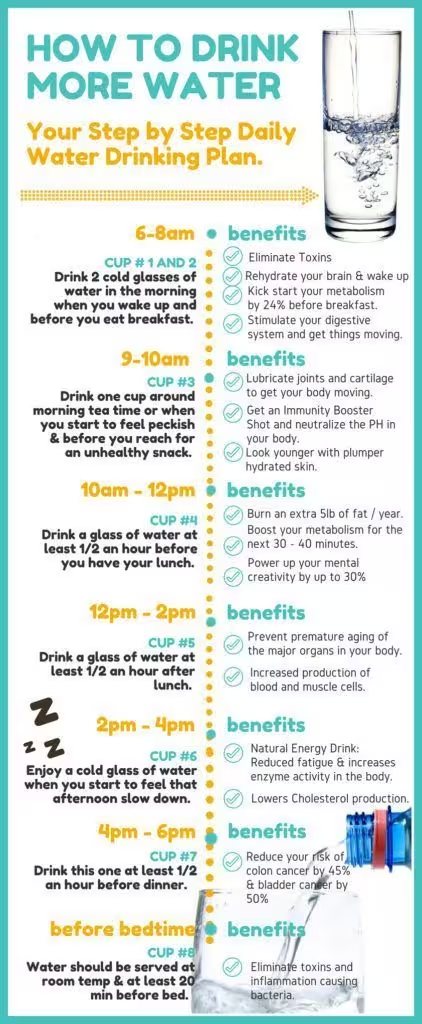
Eat it.
Several fruits and vegetables, such as melons, cucumbers, lettuce, and celery, contain a high amount of water, contributing to your hydration goals.
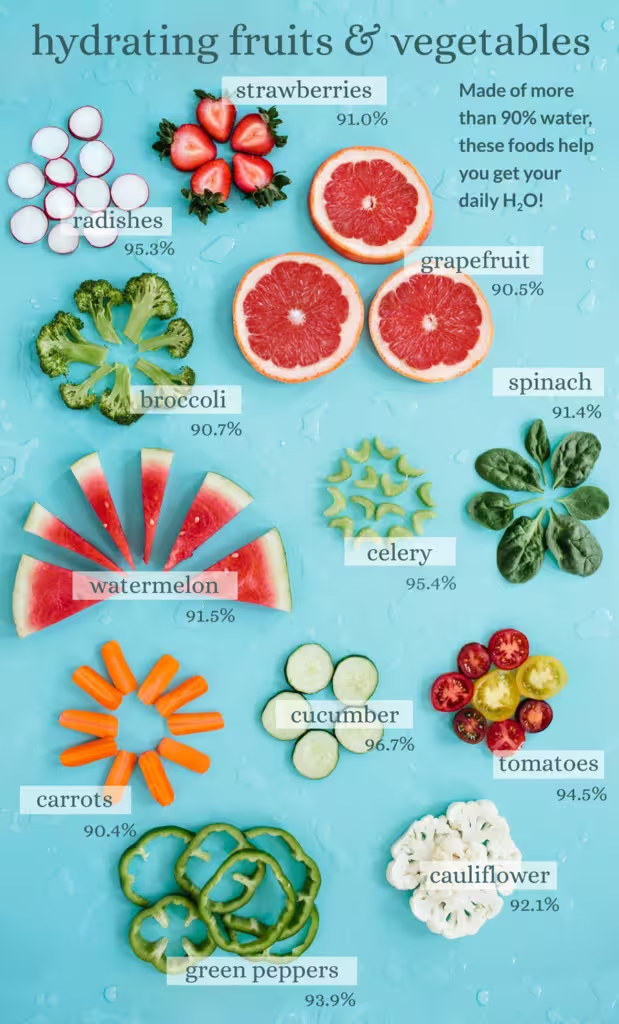
Track it.
Consider investing in a high-tech water bottle that connects to your smartphone to help you track your water intake. Alternatively, you can set an alarm as a reminder and track your intake in your calendar, ensuring you remember to stay hydrated.
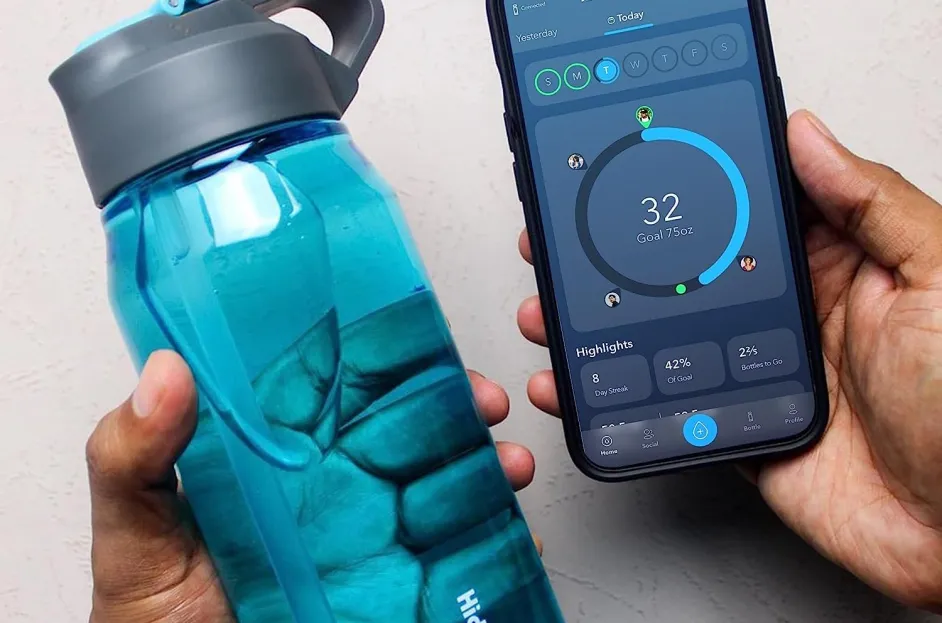
Challenge a friend.
Kickstart a friendly competition with a friend or your kids to see who can reach their hydration goal more often. This can make the effort to stay hydrated more fun and engaging.

Take it to go.
Drinking enough water while on the go can be challenging. Remember to fill your water bottle before leaving home and bring it with you on your daily travels to stay hydrated.

Alternate your drinks.
If you find it challenging to completely give up soda or juice, try switching between them and water. After finishing a glass of water, have some soda or juice, and then switch back to water. This method helps in staying hydrated while still enjoying your preferred drinks.

Soda… What does it do to our bodies?
by Trish Siems | August 20, 2024 | In Store Deals, Latest Weight Loss News, Success Stories, Weight Loss Tips | 0 Comments
Soda… What does it do to our bodies?
Soda has been a popular beverage for decades. But have you ever wondered what harmful ingredients it might contain and what they may do to your body?
Consuming soda has been linked to numerous adverse effects on the human body, as stated by the Centers for Disease Control and Prevention (CDC). These effects include an increased risk of weight gain and obesity, non-alcoholic fatty liver disease, type 2 diabetes, heart and kidney disease, as well as tooth decay and cavities. Additionally, soda consumption has been associated with an increased risk of gout. (Get the Facts: Sugar-Sweetened Beverages and Consumption | Nutrition | CDC)
Colas can cause you to pack on pounds quickly, putting you at risk for obesity and chronic disease. In addition to the calories and sugar, sodas — particularly dark-colored sodas — contain chemicals and acids that give them their distinct taste and color. These chemicals can also take a toll on your health.
Let’s dig into what chemicals found in soda can be potentially harmful to your body:
Bisphenol A – in most Soda Bottles
BPA stands for bisphenol A, an industrial chemical used to make certain plastics and resins since the 1950s.
Artificial color
The most common artificial dyes in soda are caramel color (4-mel), yellow #5, and blue #1.
Phosphoric acid and caffeine
Excessive intake of phosphoric acid changes the calcium/phosphorus ratio and imbalances not only the calcium/phosphorus ratio but also the acid-base in the body, resulting in decreased bone density, osteoporosis, and fractures.
Brominated vegetable oil
Brominated vegetable oil is used to help emulsify citrus-flavored soft drinks, preventing them from separating during distribution.
Sodium Benzoate
Known as benzoate of soda is the sodium salt of benzoic acid, widely used as a food preservative (with an E number of E211) and a pickling agent
Sodium benzoate can act as a food preservative.
High-fructose corn syrup
High-fructose corn syrup, also known as glucose-fructose, isoglucose, and glucose-fructose syrup, is a sweetener made from corn starch.
Acesulfame potassium
Acesulfame potassium, also known as acesulfame K or Ace K, is a synthetic calorie-free sugar substitute often marketed under the trade names Sunett and Sweet One.
Bisphenol A (BPA)
BPA is found in polycarbonate plastics and epoxy resins. Polycarbonate plastics, such as water bottles, are often used in food and beverage containers. They may also be used in other consumer goods.
Bisphenol A (BPA) in soda can have health risks, including:
- Possible effects on the brain and prostate gland of fetuses, infants, and children
- Affecting children’s behavior
- Increased blood pressure, type 2 diabetes, and cardiovascular disease
- Potential harm to the immune system
- Interference with endocrine function
- Risks related to heart disease, type 2 diabetes, body weight, fetal brain development, breast and prostate cancer, and asthma
Artificial Color: 4-methylimidazole (4-mel) 
4-Mel is a chemical found in sodas that produces caramel coloring. It is a chemical compound that forms a byproduct at low levels in some foods and beverages during ordinary cooking. It is used to make certain pharmaceuticals, photographic chemicals, dyes, pigments, cleaning and agricultural chemicals, and rubber products. Dark-colored sodas contain a potentially carcinogenic chemical called 4-methylimidazole (4-MeI)
The World Health Organization’s International Agency for Research on Cancer, along with the state of California, which now limits manufacturers to 29 micrograms of exposure for the average consumer per day, believes the chemical causes cancer. Large amounts of 4-Mel caused lung, liver, and thyroid cancer as well as leukemia in studies performed on rats.
In 2007, a federal government study concluded that 4-MeI caused cancer in mice, and in 2011, the International Agency for Research on Cancer determined the chemical to be “possibly carcinogenic to humans.” As of January 7, 2012, California requires manufacturers to label a product sold in the state with a cancer warning if it exposes consumers to more than 29 micrograms of 4-MeI per day. There’s no federal limit for levels of 4-MeI in foods and beverages; however, California has taken steps to address this issue.
Sodas that contain 4-Mel include Malta Goya, Pepsi One, Diet Coke, Coke, and Coke Zero.
Phosphorus and Phosphoric Acid
Phosphorus in soda can be harmful for you because:
- Excessive phosphorus intake can reduce calcium levels and hinder the body’s ability to utilize other minerals.
- Regularly consuming high amounts of soda has been associated with a higher risk of bone fractures.
- Phosphoric acid harms tooth enamel.
- Cola drinks containing phosphoric acid can be hard on the kidneys and may result in kidney damage.
Phosphorus is a mineral that keeps your bones strong and other body parts healthy. Your kidneys can’t remove extra phosphorus from your blood very well. Too much can weaken bones and damage your blood vessels, eyes, and heart. Meat, dairy, beans, nuts, whole-grain bread, and dark-colored sodas are high in phosphorus. Phosphorus is also added to lots of packaged foods.
Phosphoric acid contains phosphorus in the form of phosphate. It exists naturally in foods such as meat and dairy, but the type added to soda is synthesized. Phosphoric acid is added to soft drinks to help prevent the growth of molds and bacteria in sugary formulas and to provide a sharper after-taste.
The consumption of soda is undeniably linked to a higher risk of bone fractures, even in teenagers, and an increased risk of developing osteoporosis. Minerals such as calcium unquestionably provide strength and density to bones; therefore, reduced mineralization undeniably leads to weak or brittle bones. Moreover, another significant reason why drinking sodas may weaken bones is that they often undoubtedly replace calcium-rich milk in the diets of children and teenagers. Furthermore, caffeine can surely interfere with calcium absorption and unquestionably contribute to lower bone density.
Health Risks of Fructose in Dark Soda
Regular colas contain fructose, a high-fructose corn sweetener component that the body metabolizes and stores as fat. Furthermore, the dark color of colas is attributed to chemicals, and the artificial sweeteners in diet colas can potentially contribute to increased fat storage.
It’s important to be mindful of fat accumulation, as it can lead to nonalcoholic fatty liver disease and potentially progress to cirrhosis, a serious condition marked by liver scarring. A 2015 study published in the Journal of Hepatology highlighted the link between consuming fructose and the increased risk of developing this condition. The study also found that adults who drank more than one sugary beverage per day were 55% more likely to have fatty liver disease compared to those who did not.
Brominated vegetable oil (BVO)
Brominated vegetable oil (BVO) is included in sodas to keep the artificial flavors and the rest of the soda from separating. While it might do its job, it’s also linked to health issues such as memory loss, nerve disorders, and skin conditions. BVO is in many types of beverages. It’s commonly found in beverages such as Fanta, Mountain Dew, and Gatorade. One of the main components in BVO is bromine, the same element found in brominated flame retardants.
What is brominated vegetable oil, and why did the FDA ban it in food? | Live Science
ACE-K 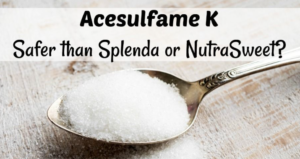
It is around 200 times sweeter than sugar and is used to give food and drinks a sweet taste without adding calories (2Trusted Source). Acesulfame works by stimulating the sweet-taste receptors on the tongue so a person can enjoy the taste of sweetness without consuming sugar.
Manufacturers usually blend acesulfame potassium with other sweeteners, such as aspartame and sucralose, to mask the bitter aftertaste that sweeteners can have on their own. Interestingly, the body may not break down or store acesulfame potassium as it does with other food. Instead, the body absorbs it and then passes it, unchanged, through urine.
The CSPI Trusted Source states that despite the limitations of early research, there are health concerns associated with Ace-K, including cancer, hormone disruption, and risks to pregnant individuals. Additionally, there is evidence that acetoacetamide, a substance formed in the body during the breakdown of Ace-K, can cause thyroid damage in laboratory animals.
Finally, a study determined that the chronic use of Ace-K in male mice was linked to possible changes in brain function over a period of 40 weeks.
4 Tips to Sip Sugar/Chemical-Free
- Read nutrition labels and ingredients. Drinks that may seem reasonable for you, like energy drinks and bottled smoothies, could be loaded with added sugars. Look for these terms in the ingredients list: sucrose, glucose, maltose, dextrose, syrups, concentrated fruit juice, agave, and honey. Read the Nutrition Facts label carefully. One container may be more than one serving, which can double or triple the added sugars you’re getting.
- Cut back slowly. If you regularly drink sugary beverages, slowly incorporate less sweet versions into your day. For example, stir together half-sweetened iced tea with half-unsweetened iced tea. Gradually reduce the number of sweetened beverages.
- Choose water. Plain water is your body’s preferred way to hydrate, and it’s naturally sugar-free. Here are some ways to make drinking water easy and more enjoyable:
- Carry a refillable water bottle or keep a cup at your desk to make water the go-to choice.
- Add slices of your favorite fruits for a boost of flavor.
- Try seltzer or sparking water if you prefer fizzy carbonated drinks.
-
- Sip a smoothie. When you’re in the mood for something sweet or need an afternoon energy boost, skip the sweetened coffee and soda. Instead, whip up a homemade smoothie. Toss any fruits and/or vegetables you have on hand into a blender with ice, fat-free, or low-fat milk or yogurt.
Slim180 High-protein Snacks, why are they important?
by adminss | August 13, 2024 | In Store Deals, Latest Weight Loss News, Recipes, Weight Loss Tips | 0 Comments
Slim180 High-protein Snacks Play a crucial role in successful weight loss!!
Here’s why:
Muscle Maintenance: It’s common to lose fat and muscle during weight loss. Protein helps preserve and build lean muscle mass, essential for maintaining a high metabolic rate.
Blood Sugar Stabilization: Low-calorie, high-protein snacks slow digestion and help stabilize blood sugar levels, reducing hunger and preventing overeating at the next meal.
Satiety and Appetite Regulation: Protein-rich foods are highly satiating, meaning they help keep you full and satisfied for extended periods. They increase levels of appetite-reducing hormones (GLP-1, peptide YY, and cholecystokinin) while reducing the hunger hormone ghrelin. This can naturally lead to consuming fewer calories overall.
Calorie Burn: Digesting and metabolizing protein burns more calories than carbs or fat. Approximately 20-30% of protein calories are used during digestion, contributing to weight loss.
Increased Metabolism: A high protein intake boosts metabolism, especially during overfeeding. It makes you burn more calories around the clock, even during sleep.
Healthy Snack Options: Choose high-protein snacks with at least 7 grams of protein per serving. These can support weight loss while providing other health benefits like muscle growth and healthy digestion. Slim180 Snacks have 10-15 grams of protein per serving.
Slim180 has incorporated a specific combination of amino acids required to aid in weight reduction naturally. Amino acids are the “building blocks” of all proteins. Protein stimulates metabolism by allowing your body to burn up to 30% of its calories through digestion.
Amino acids:
-
Ensure proper nitrogen balance
-
Appetite suppression
-
Regulate the body’s metabolic rate
-
The body cannot produce essential amino acids; they must be obtained from food
Benefits of protein Slim Snacks:
-
Stimulates the metabolism above its standard rates
-
Increases energy
-
Decreases hunger
-
Adds variety to help prevent deviating
-
Improves skin and hair
-
Regulates water balance
-
Fewer plateaus
-
Stimulates new cell growth
-
It helps repair damaged tissue
Use 3 Slim Snacks per day. Be sure to eat them before 9:00 p.m. You may enjoy snacks in between meals, with your meals, or when cooking.
Uncover the Power of Slim180’s All-Natural Supplements to Accelerate Your Weight Loss
by Trish Siems | August 5, 2024 | In Store Deals, Latest Weight Loss News, Success Stories, Weight Loss Tips | 0 Comments
Uncover the Power of Slim180’s All-Natural Supplements to Accelerate Your Weight Loss
All-natural Slim180 weight loss supplements contain a variety of natural ingredients to support health and wellness during weight loss journeys.
NEURO TRIM
Chromium: low chromium levels, lowering blood sugar, antioxidant, improves lean body mass, helps reduce hunger, fights cravings and overeating
Bitter Orange: Maintains blood sugar levels, lipid levels, Antioxidants
CHA De Burge: treat cellulite, improve blood circulation and heart function, improve blood pressure
Green Tea: increases fat burning and breaks down excess fat
Mucuna Purines L-Dopa: lowers stress, reduces anxiety, improves focus, boosts the libido, and elevates mood
Garcinia Cambogia: help keep blood sugar and cholesterol levels in check
ISO CAPP
Guarana: Rich in antioxidants, reduces fatigue and improves focus
Bitter Orange: Maintains blood sugar levels, lipid levels, Antioxidants
Ginkgo: Improves circulation and heart health, lowers blood sugar, reduces anxiety, can help fight inflammation, contains antioxidants, improves brain function, supports vision and eye health, can improve asthma, helps reduce PMS Symptoms
Nutmeg: antibacterial properties, boosts libido, anti-inflammatory properties, lowers blood pressure
Thyro-Cap
Blue-Green Algae: source of dietary protein, B vitamins, and iron
Bromelain: reduces inflammation, improving digestion
Lecithin: Lowers cholesterol, improves heart health, improves digestion, soothes and moisturizes skin
Kelp: high in antioxidants, benefits to cardiovascular health
Apple Cider Vinegar: Reduces belly fat, lowers blood sugars, improves heart health, lowers cholesterol, kills harmful bacteria
ISO-H2O
Vitamin B-6: helps jumpstart weight loss because it helps the body metabolize fat and reduce water retention
Folate 1360: Help keep water off the body during weight loss
Vitamin b-12: B12 also reduces water retention owing to its diuretic attributes.
ISO PHEN-STIM
Niacin – B vitamin that’s made and used by your body to turn food into energy
Magnesium – dietary components with proven antioxidant and anti-inflammatory activity
Bitter Orange: Maintains blood sugar levels, lipid levels, Antioxidants
Cayenne – improves heart health, promotes weight loss, improves digestion, improves blood sugar control, and strengthens immunity
Nutmeg: antibacterial properties, boosts libido, anti-inflammatory properties, lowers blood pressure
Carb Blocker
Great Northern Beans: reducing cholesterol, decreasing blood sugar levels, and increasing healthy gut bacteria
Mulberry: activates brown fat, reduces cholesterol, improves blood sugar levels
Gymnema: lowering blood sugar levels and reducing sugar cravings, influence fat absorption and lipid levels
Cleansing Tea
Senna, Leaf: help relieve constipation
Apple: rich in essential antioxidants, flavonoids, and dietary fiber
Juniper: anti-inflammatory and antioxidant, promotes heart health, antibacterial and antifungal activities
Hibiscus: prevent hypertension, lower blood pressure, reduce blood sugar levels, keep your liver healthy, help with menstrual cramps, help with depression
Birch: possesses antibacterial, antiseptic, counterirritant, astringent and anti-inflammatory activity
Stinging Nettle: reduces inflammation, treats hay fever and low blood pressure, aids in blood sugar control
EFA
Omega-3 Fatty Acids: Fight depression and anxiety, improve eye health, promote brain health, and improve risk factors for heart disease.
Omega6 Fatty Acids: reducing the risk of heart disease, lowering total cholesterol levels, lowering “bad” (LDL) cholesterol levels, raising “good” (HDL) cholesterol levels, and reducing cancer risk.
Learn more about our REGENERATE Weight Loss featuring Semaglutide Weight loss Injections:
Semaglutide Weight Loss Shots Regenerate Weight Loss Program Slim180 Weight Loss (myslim180.com)
Learn more about our CRAVE Weight Loss featuring Tirzeaptide Weight loss Injections:
Tirzepatide Weight Loss – Crave Weight Loss Program – Slim180 Weight Loss (myslim180.com)
After I finish taking Semaglutide or Tirzepatide, will I regain my weight?
by Trish Siems | July 3, 2024 | In Store Deals, Latest Weight Loss News, Success Stories, Weight Loss Tips | 0 Comments
At Slim180, we don’t believe you must be on Semaglutide or Tirzepatide forever to maintain long-term weight loss. We view Semaglutide or Tirzepatide and other weight-loss injections as a tool to accelerate weight loss.

Can you keep weight off after stopping Semaglutide or Tirzepatide?
“The research is clear that it is challenging for most people to keep their weight off after stopping Semaglutide,” says Dr. Lauren Lemieux, an internist and obesity medicine specialist in Boston. “This is despite trying to stick with healthy eating and regular physical activity, which was helping them lose weight in the first place.”
Lemieux says weight gain after semaglutide use doesn’t mean you did something wrong or lack willpower. It’s the natural consequence of increased appetite and reduced feelings of fullness once the medication has left your system.
Weight maintenance after stopping Semaglutide or Tirzepatide is a significant challenge, but it’s not insurmountable. Whether or not medication is involved, maintenance is the most demanding part of a weight loss journey. While it may be difficult, there are strategies to help prevent weight regain after stopping Semaglutide or Tirzepatide:
Follow the Slim180 Nutritional Guidance Program:
This program is designed to help you develop healthy eating habits, achieve sustainable weight loss, and ensure long-term maintenance of your achievements. (ASK ABOUT OUR GUARANTEE!)

Continue with professional guidance:
Working with a team of professionals, such as Slim180 Weight Loss Counselors, may help you keep momentum for long-term weight management.
Improve the quality of your diet while using Semaglutide or Tirzepatide:
Eating a diet based on whole foods and minimizing the consumption of ultra-processed foods will help your body naturally regulate your appetite.
Exercise:
Research has shown that people who exercise more after weight loss are more likely to avoid weight regain in the long term.
Address the underlying causes of overeating:
Weight loss is as much about understanding why we eat as it is about how and what. If we can identify the underlying causes of our overeating, we’ll be more able to address them. These could be emotional eating, environmental triggers, or other psychological-related causes like previous trauma.

Do I need to stay on Semaglutide or Tirzepatide forever?
We rarely, if ever, recommend relying on Semaglutide or Tirzepatide as a permanent solution. They are designed to provide a temporary break, allowing individuals to begin a journey to uncover and address the root causes of their weight gains.
Imagine a dynamic duo of Weight Loss Programs and counseling joining forces to tackle the root of the issue! Enter Semaglutide and Tirzepatide, our powerful allies, in quieting the overwhelming ‘food noise’ that often disrupts people’s ability to find their eating off-switch. Together, they work synergistically to help individuals regain control and find peace in their food-related relationships. It’s an incredible breakthrough in the journey towards a healthier and happier life!
These medications interact with the brain’s appetite control center, the hypothalamus, to provide an opening for treatment. This allows individuals the time and space to address the underlying behavioral, psychological, and environmental causes of their weight gains.
Some people have specific genetic predispositions to hunger and cravings that only medication may address. However, many people will likely use Semaglutide or Tirzepatide to kickstart their weight loss journey and develop the healthy habits required to rewire their brains and keep their cravings at bay.
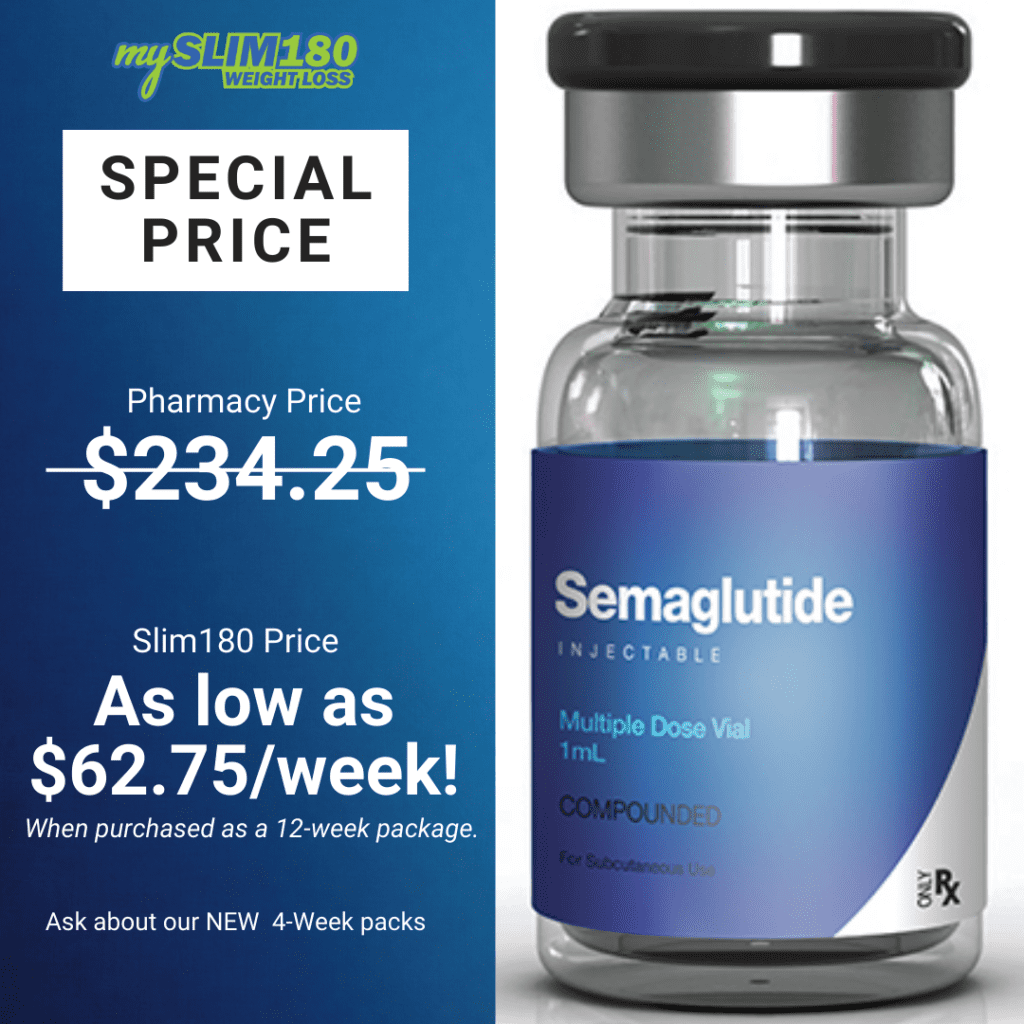
What do I do if I gain my weight back quickly?
It’s important to remember that if you gain weight back quickly after stopping semaglutide or tirzepatide, it’s not your fault. However, it can be a challenging and frustrating experience. It’s essential to look compassionate at everything that’s changed since discontinuing the medication.
Have there been shifts in the behaviors that were helping you lose weight in the first place, like tracking foods? It’s natural not to realize just how much your lifestyle has changed after stopping semaglutide or tirzepatide.
Consider keeping up with daily food tracking and an activity journal to help identify patterns that might contribute to rapid weight gain. Contact your Slim180 Counselors to rule out dietary changes that could impact the gains.
The Slim180 Difference
Slim180 has a mission: to help each of our clients improve their quality of life and health with permanent weight loss solutions. Our counselors provide encouragement and support to help you accomplish your weight loss goals. We firmly believe that everyone deserves to live a healthy and happy life!
The effective approach to weight loss used at Slim180 makes the difference! Easy-to-follow meal plans do not involve counting calories, fat grams, or carbohydrates. The emphasis is on eating real food. Slim180 does not offer pre-packaged foods because our clients need the tools, knowledge, and education to keep their weight off permanently.
For over a decade, Slim180 has been dedicated to serving clients in St. Louis, delivering highly effective weight-loss programs with and without weight-loss injections. Slim180 Semaglutide and Tirzepatide weight-loss programs are known for producing accelerated results, all while prioritizing scientific evidence and client safety.
For example, individuals using Semaglutide typically experience a weight loss of 1-3 lbs. per week, depending on their dietary habits. When combining Semaglutide with the Slim180 Nutritional Guidance Program, we have observed weight losses of 3-5 lbs. or more weekly!


Slim180 Has 6 Locations In The St. Louis Area
Visit a Slim180 near you in Sunset Hills, O’Fallon, St. Charles, Creve Coeur, Chesterfield & Florissant.
Scroll down this page for complete contact information for the Slim180 Weight Loss Center near you!
You can also call our toll free number:
888.754.6111



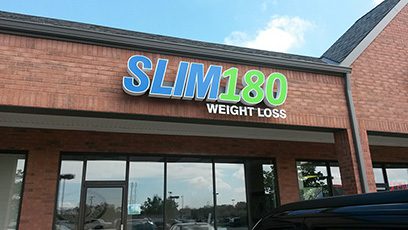

Slim180 Weight Loss Sunset Hills
3828 South Lindbergh Blvd. Suite 102
St. Louis Missouri 63127, USA
Slim180 Weight Loss Chesterfield
36 Clarkson Wilson Center
Chesterfield Missouri 63017, USA
Slim180 Creve Coeur
Slim180 Weight Loss Creve Coeur
10905 Olive Blvd.St. Louis Missouri 63141 United StatesSlim180 Sunset Hills
Slim180 Chesterfield
Slim180 Weight Loss Chesterfield
636-536-3904
Slim180 O'Fallon
Slim180 St. Charles
Slim180 Florissant


